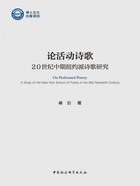
Abstract
Poetry is the oldest literary form and has long flourished in multimedia through the long history of human civilization.Poems were originally carried by the voice integrated with music and dance,which were sung,chanted and performed in rituals,fields,or entertaining events.As the printing technology dominated the dissemination of culture,poetry was shifted into the textual form and the institution of poetry was centered around writing text.However,with the advent of acoustical technologies,the oral and performative dimension of poetry was reclaimed in the late nineteenth century and has been rejuvenated since the 1950s.However,the critical attention to the poetry-in-performance has been neglected and the poetry-in-text is still the focus.The New York School of Poets,including Frank O'Hara,John Ashbery,Kenneth Koch,James Schuyler,and Barbara Guest,were avant-gardists in poetry experiments and trans-media collaborations.In the middle of twentieth century,their poetry readings,poetry-painting,poetry-theatre,poetry-film,and poetry-music collaborations served as a new trend in contemporary American poetry,which has had an enormous impact on the American history of literature and art.
Distinct from the traditional way of poetry study,this book positions the sound and performative dimensions of poetry into the spotlight.And the two concepts of “textualized poetry” and “performed poetry” are presented and differentiated.The generation,dissemination,aesthetic modes,and acceptance of performed poetry are analyzed,which also ushers in the clarification of its legitimacy and existing institution in contemporary times.
The Introduction discusses the necessity of advancing the concept of “performed poetry” and probes into its interaction with the society,technology,and literary genre.The relation between the New York school poetry in performance and the American history of poetry is introduced.This part also reaches out to a literature review and the realistic implication of this study.
The first chapter approaches the notion of “performed poetry” and traces its origins in the East and the West.The conventional features of the performed poetry helped shaping the poetic forms on page with the rise of the printing culture.The newly emerging Performance Studies and the expansion of poetry-in-performance in the middle of the twentieth century served as witnesses to each other.What the New York school of poets performed and collaborated define themselves against the mainstream of modernists’ poetry and New Criticism.
Chapter 2 focuses on the public poetry readings and poetry-theatre experiments of the New York school of poets.The text of poetry recedes as “script” in poetry performance,while the presence of sound and performance in the process serves as poetry itself.The unique “nonperformance” reading style of the poets reveal their poetic thoughts and ideological inclination.Meanwhile,their poetry-theatre experiments served as an early stage of Broadway movement as well as Postdramatic theatre as defined by Hans-Thies Lehman.
Chapter 3 emphasizes on the collaborations between the New York School of Poets and the painters,film directors and musicians.“Contextual practice” rather than text composition constituted the process of poetry creation.Language as a kind of material was integrated with other mediums,which broke down the barriers among different art forms and dissolved the boundaries between art and life.Through these poetic experiments and practices,the avant-garde poets established a poetic and artistic community which was full of creativity as well as contradiction.
Chapter 4 discusses time,space,and audience of performed poetry. In poetry performance,the time is diverted from “symbol time” to “event time” and “set time”,while the former imagined space becomes actual places and the recording archives the virtual space.There is also a shift from “poet-reader-text” mode to “poet/performer-audience or participant-public space” one.All the above changes facilitate a kind of “performed poetry institution” in which the recording archives set the legitimacy for it and provide chances for “close reading” and “close scrutinizing” to share the aesthetic and teaching function of “close reading”,which in turn molds a new spatial arena for the poets as well as new scenario for the history of poetry.
The fifth chapter is a summary of the poetics of performed poetry,which is manifested in the process presented by action rather than text,the “communication” reflected in the shift from “intertextuality” to “inter-referentiality”,and the “materiality” unfolds from symbol to substance.
The Conclusion points out that the concept of “performed poetry” would help shatter the prevalent notion that poetry is parallel to the poetry-in-text and shed light on the authenticity of poetry-in-performance.It is an echo to the poetry sung,chanted and performed in the distant part as well as to the contemporary time with turbulent changes.
Key words:Performed poetry;The New York School of Poets;The sound of poetry;Poetry performance;Trans-media Collaboration;“The Institutional Theory of Poetry”